Qing Zhou
Towards Seamless Interaction: Causal Turn-Level Modeling of Interactive 3D Conversational Head Dynamics
Dec 17, 2025Abstract:Human conversation involves continuous exchanges of speech and nonverbal cues such as head nods, gaze shifts, and facial expressions that convey attention and emotion. Modeling these bidirectional dynamics in 3D is essential for building expressive avatars and interactive robots. However, existing frameworks often treat talking and listening as independent processes or rely on non-causal full-sequence modeling, hindering temporal coherence across turns. We present TIMAR (Turn-level Interleaved Masked AutoRegression), a causal framework for 3D conversational head generation that models dialogue as interleaved audio-visual contexts. It fuses multimodal information within each turn and applies turn-level causal attention to accumulate conversational history, while a lightweight diffusion head predicts continuous 3D head dynamics that captures both coordination and expressive variability. Experiments on the DualTalk benchmark show that TIMAR reduces Fréchet Distance and MSE by 15-30% on the test set, and achieves similar gains on out-of-distribution data. The source code will be released in the GitHub repository https://github.com/CoderChen01/towards-seamleass-interaction.
Nonlinear Causal Discovery through a Sequential Edge Orientation Approach
Jun 05, 2025Abstract:Recent advances have established the identifiability of a directed acyclic graph (DAG) under additive noise models (ANMs), spurring the development of various causal discovery methods. However, most existing methods make restrictive model assumptions, rely heavily on general independence tests, or require substantial computational time. To address these limitations, we propose a sequential procedure to orient undirected edges in a completed partial DAG (CPDAG), representing an equivalence class of DAGs, by leveraging the pairwise additive noise model (PANM) to identify their causal directions. We prove that this procedure can recover the true causal DAG assuming a restricted ANM. Building on this result, we develop a novel constraint-based algorithm for learning causal DAGs under nonlinear ANMs. Given an estimated CPDAG, we develop a ranking procedure that sorts undirected edges by their adherence to the PANM, which defines an evaluation order of the edges. To determine the edge direction, we devise a statistical test that compares the log-likelihood values, evaluated with respect to the competing directions, of a sub-graph comprising just the candidate nodes and their identified parents in the partial DAG. We further establish the structural learning consistency of our algorithm in the large-sample limit. Extensive experiments on synthetic and real-world datasets demonstrate that our method is computationally efficient, robust to model misspecification, and consistently outperforms many existing nonlinear DAG learning methods.
Scale Efficient Training for Large Datasets
Mar 17, 2025



Abstract:The rapid growth of dataset scales has been a key driver in advancing deep learning research. However, as dataset scale increases, the training process becomes increasingly inefficient due to the presence of low-value samples, including excessive redundant samples, overly challenging samples, and inefficient easy samples that contribute little to model improvement.To address this challenge, we propose Scale Efficient Training (SeTa) for large datasets, a dynamic sample pruning approach that losslessly reduces training time. To remove low-value samples, SeTa first performs random pruning to eliminate redundant samples, then clusters the remaining samples according to their learning difficulty measured by loss. Building upon this clustering, a sliding window strategy is employed to progressively remove both overly challenging and inefficient easy clusters following an easy-to-hard curriculum.We conduct extensive experiments on large-scale synthetic datasets, including ToCa, SS1M, and ST+MJ, each containing over 3 million samples.SeTa reduces training costs by up to 50\% while maintaining or improving performance, with minimal degradation even at 70\% cost reduction. Furthermore, experiments on various scale real datasets across various backbones (CNNs, Transformers, and Mambas) and diverse tasks (instruction tuning, multi-view stereo, geo-localization, composed image retrieval, referring image segmentation) demonstrate the powerful effectiveness and universality of our approach. Code is available at https://github.com/mrazhou/SeTa.
A Benchmark for Multi-Lingual Vision-Language Learning in Remote Sensing Image Captioning
Mar 06, 2025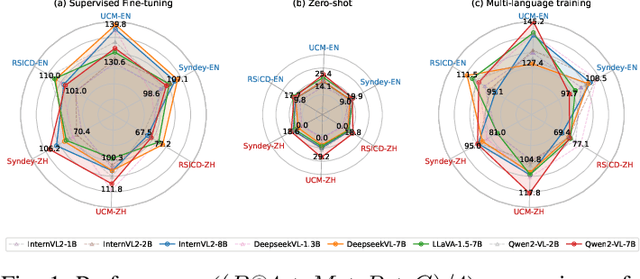
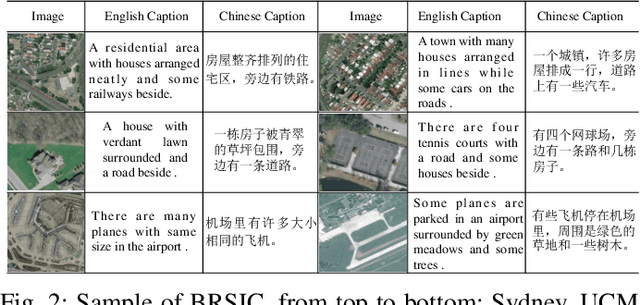
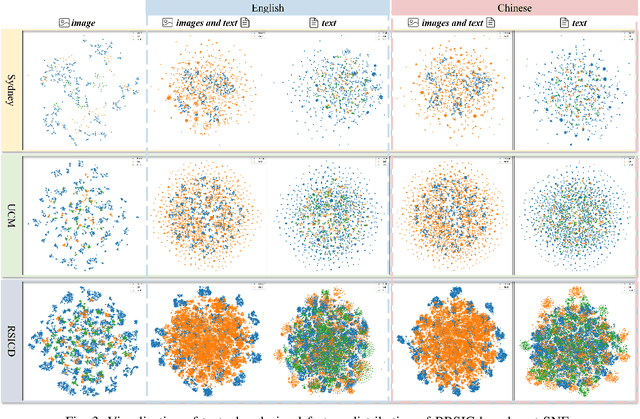

Abstract:Remote Sensing Image Captioning (RSIC) is a cross-modal field bridging vision and language, aimed at automatically generating natural language descriptions of features and scenes in remote sensing imagery. Despite significant advances in developing sophisticated methods and large-scale datasets for training vision-language models (VLMs), two critical challenges persist: the scarcity of non-English descriptive datasets and the lack of multilingual capability evaluation for models. These limitations fundamentally impede the progress and practical deployment of RSIC, particularly in the era of large VLMs. To address these challenges, this paper presents several significant contributions to the field. First, we introduce and analyze BRSIC (Bilingual Remote Sensing Image Captioning), a comprehensive bilingual dataset that enriches three established English RSIC datasets with Chinese descriptions, encompassing 13,634 images paired with 68,170 bilingual captions. Building upon this foundation, we develop a systematic evaluation framework that addresses the prevalent inconsistency in evaluation protocols, enabling rigorous assessment of model performance through standardized retraining procedures on BRSIC. Furthermore, we present an extensive empirical study of eight state-of-the-art large vision-language models (LVLMs), examining their capabilities across multiple paradigms including zero-shot inference, supervised fine-tuning, and multi-lingual training. This comprehensive evaluation provides crucial insights into the strengths and limitations of current LVLMs in handling multilingual remote sensing tasks. Additionally, our cross-dataset transfer experiments reveal interesting findings. The code and data will be available at https://github.com/mrazhou/BRSIC.
Causal bandits with backdoor adjustment on unknown Gaussian DAGs
Feb 04, 2025Abstract:The causal bandit problem aims to sequentially learn the intervention that maximizes the expectation of a reward variable within a system governed by a causal graph. Most existing approaches assume prior knowledge of the graph structure, or impose unrealistically restrictive conditions on the graph. In this paper, we assume a Gaussian linear directed acyclic graph (DAG) over arms and the reward variable, and study the causal bandit problem when the graph structure is unknown. We identify backdoor adjustment sets for each arm using sequentially generated experimental and observational data during the decision process, which allows us to estimate causal effects and construct upper confidence bounds. By integrating estimates from both data sources, we develop a novel bandit algorithm, based on modified upper confidence bounds, to sequentially determine the optimal intervention. We establish both case-dependent and case-independent upper bounds on the cumulative regret for our algorithm, which improve upon the bounds of the standard multi-armed bandit algorithms. Our empirical study demonstrates its advantage over existing methods with respect to cumulative regret and computation time.
Causal Discovery on Dependent Binary Data
Dec 28, 2024Abstract:The assumption of independence between observations (units) in a dataset is prevalent across various methodologies for learning causal graphical models. However, this assumption often finds itself in conflict with real-world data, posing challenges to accurate structure learning. We propose a decorrelation-based approach for causal graph learning on dependent binary data, where the local conditional distribution is defined by a latent utility model with dependent errors across units. We develop a pairwise maximum likelihood method to estimate the covariance matrix for the dependence among the units. Then, leveraging the estimated covariance matrix, we develop an EM-like iterative algorithm to generate and decorrelate samples of the latent utility variables, which serve as decorrelated data. Any standard causal discovery method can be applied on the decorrelated data to learn the underlying causal graph. We demonstrate that the proposed decorrelation approach significantly improves the accuracy in causal graph learning, through numerical experiments on both synthetic and real-world datasets.
MMO-IG: Multi-Class and Multi-Scale Object Image Generation for Remote Sensing
Dec 18, 2024



Abstract:The rapid advancement of deep generative models (DGMs) has significantly advanced research in computer vision, providing a cost-effective alternative to acquiring vast quantities of expensive imagery. However, existing methods predominantly focus on synthesizing remote sensing (RS) images aligned with real images in a global layout view, which limits their applicability in RS image object detection (RSIOD) research. To address these challenges, we propose a multi-class and multi-scale object image generator based on DGMs, termed MMO-IG, designed to generate RS images with supervised object labels from global and local aspects simultaneously. Specifically, from the local view, MMO-IG encodes various RS instances using an iso-spacing instance map (ISIM). During the generation process, it decodes each instance region with iso-spacing value in ISIM-corresponding to both background and foreground instances-to produce RS images through the denoising process of diffusion models. Considering the complex interdependencies among MMOs, we construct a spatial-cross dependency knowledge graph (SCDKG). This ensures a realistic and reliable multidirectional distribution among MMOs for region embedding, thereby reducing the discrepancy between source and target domains. Besides, we propose a structured object distribution instruction (SODI) to guide the generation of synthesized RS image content from a global aspect with SCDKG-based ISIM together. Extensive experimental results demonstrate that our MMO-IG exhibits superior generation capabilities for RS images with dense MMO-supervised labels, and RS detectors pre-trained with MMO-IG show excellent performance on real-world datasets.
STDA: Spatio-Temporal Dual-Encoder Network Incorporating Driver Attention to Predict Driver Behaviors Under Safety-Critical Scenarios
Aug 03, 2024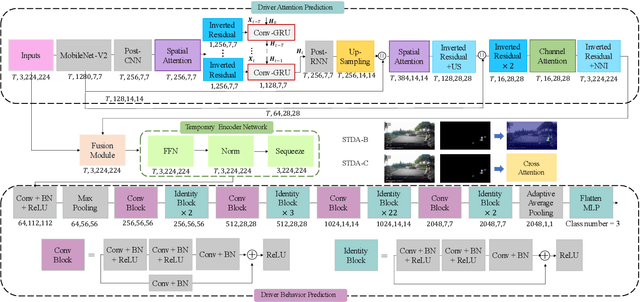
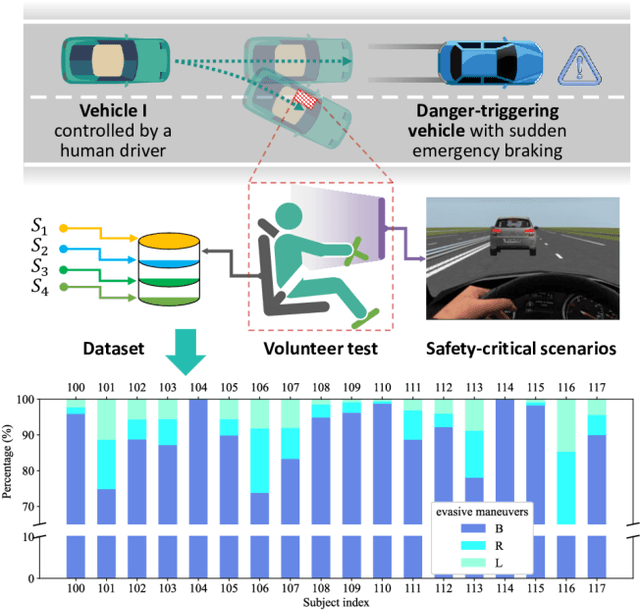

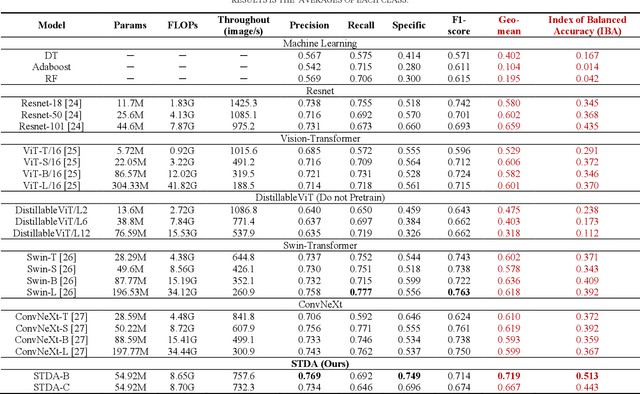
Abstract:Accurate behavior prediction for vehicles is essential but challenging for autonomous driving. Most existing studies show satisfying performance under regular scenarios, but most neglected safety-critical scenarios. In this study, a spatio-temporal dual-encoder network named STDA for safety-critical scenarios was developed. Considering the exceptional capabilities of human drivers in terms of situational awareness and comprehending risks, driver attention was incorporated into STDA to facilitate swift identification of the critical regions, which is expected to improve both performance and interpretability. STDA contains four parts: the driver attention prediction module, which predicts driver attention; the fusion module designed to fuse the features between driver attention and raw images; the temporary encoder module used to enhance the capability to interpret dynamic scenes; and the behavior prediction module to predict the behavior. The experiment data are used to train and validate the model. The results show that STDA improves the G-mean from 0.659 to 0.719 when incorporating driver attention and adopting a temporal encoder module. In addition, extensive experimentation has been conducted to validate that the proposed module exhibits robust generalization capabilities and can be seamlessly integrated into other mainstream models.
Unveiling Incomplete Modality Brain Tumor Segmentation: Leveraging Masked Predicted Auto-Encoder and Divergence Learning
Jun 12, 2024



Abstract:Brain tumor segmentation remains a significant challenge, particularly in the context of multi-modal magnetic resonance imaging (MRI) where missing modality images are common in clinical settings, leading to reduced segmentation accuracy. To address this issue, we propose a novel strategy, which is called masked predicted pre-training, enabling robust feature learning from incomplete modality data. Additionally, in the fine-tuning phase, we utilize a knowledge distillation technique to align features between complete and missing modality data, simultaneously enhancing model robustness. Notably, we leverage the Holder pseudo-divergence instead of the KLD for distillation loss, offering improve mathematical interpretability and properties. Extensive experiments on the BRATS2018 and BRATS2020 datasets demonstrate significant performance enhancements compared to existing state-of-the-art methods.
Text-only Synthesis for Image Captioning
May 28, 2024



Abstract:From paired image-text training to text-only training for image captioning, the pursuit of relaxing the requirements for high-cost and large-scale annotation of good quality data remains consistent. In this paper, we propose Text-only Synthesis for Image Captioning (ToCa), which further advances this relaxation with fewer human labor and less computing time. Specifically, we deconstruct caption text into structures and lexical words, which serve as the fundamental components of the caption. By combining different structures and lexical words as inputs to the large language model, massive captions that contain various patterns of lexical words are generated. This method not only approaches the target domain but also surpasses it by generating new captions, thereby enhancing the zero-shot generalization ability of the model. Considering the different levels of data access in the real world, we define three synthesis scenarios: cross-domain synthesis, in-domain synthesis, and data-efficient synthesis. Experiments in these scenarios demonstrate the generalizability, transferability and practicability of ToCa with a nearly 5 CIDEr improvement for zero-shot cross-domain captioning and a maximum increase of over 20 CIDEr for data-efficient captioning.
 Add to Chrome
Add to Chrome Add to Firefox
Add to Firefox Add to Edge
Add to Edge